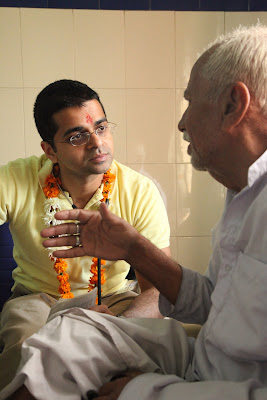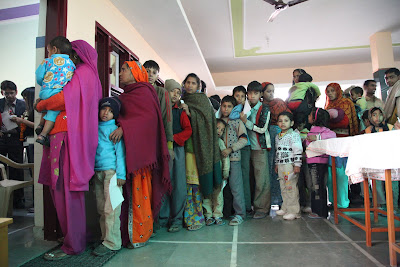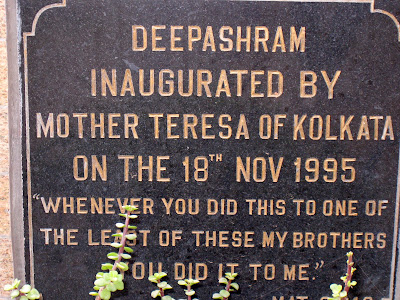photos by Jennifer MacFarlane
Full of inspiration, color, spices, bangles, Ayurveda, Hindi goddesses and gods...
You could see, smell, and hear the variation in language, religion, and people as you disembark the plane. Our mission was to 'breathe in' all of these new sights, smells, and color while organizing our first public health project in India. We were not just hungry for curry and paneer, but a new learning experience where we could have a cross cultural exchange while helping others. Our focus was on helping women and children by setting up rural health clinics for check-ups, free medication, and vitamins. To educate the community, we made a water color mural with children describing their community, and the dangers affecting it. We developed posters and pamphlets around poison control safety in Hindi so that women and children would become more aware of toxins affecting their health. We also partnered with Gurgaon Civil Hospital to teach ultrasound education as well as educate hospital staff on how to use the EKG machine we donated. Sounds like a lot to do in 2 weeks and we are always amazed about how much we accomplish in such a short amount of time. We served over 600 families.
If you are wondering who 'we' are; our team is made up of 8 doctors, 3 nurses, social worker (me), 2 pre-med students, 1 researcher, 1 nutritionist, 1 water color painter/teacher, and a phenomenal photojournalist whose pictures tell our story in action (www.jennifermacfarlane.com).
If you are wondering who 'we' are; our team is made up of 8 doctors, 3 nurses, social worker (me), 2 pre-med students, 1 researcher, 1 nutritionist, 1 water color painter/teacher, and a phenomenal photojournalist whose pictures tell our story in action (www.jennifermacfarlane.com).
Day 1: Tawdu, Gurgaon
A pre-school girl at the Anganwadi we worked in welcomes us to her class with a 'Namaste'
(the light in me, greets the light in you)
Teaching poison control and safety using the poster I am holding (showing pictorials and explanations in Hindi). Our team member, Bipasha Das (nutritionist), translated along with the Anganwadi leaders.
Children eager to learn (and also wondering what planet we came from).
No, he's not dangerous-but he learned that by using this universal danger sticker that we gave out, he can label containers with poisonous materials.
"I made a puppet of myself, now when can I start that community mural"
"I am a part of the mural now!"
Youth who are showing their natural talent.
Young mother and daughter observing.
Caitlin Blaskewicz (Research and Education section leader) and I doing a needs assessment with Anganwadi Director.
Tour through the village of Tawdu-me (Zola) with the Anganwadi Director
The women we met invited us to their houses. We ate roti bread and buffalo butter at one woman's house. It was really enlightening to see the way of life in Tawdu.
Beautiful elephant strolling through the village of Tawdu. I wanted to take a ride.
Me and Anganwadi Director taking a photo memory together before departure. We were able to speak about ongoing supports needed.
While the community team went out to do community health work, the hospital team focused on ultrasound and EKG education. Dr. Thea James (co-founder and clinical section leader), is ready for whatever comes in the door in Gurgaon Civil Hospital (GCH). GCH is a hospital that takes uninsured patients.
Using ultrasound machine to determine the source of the patient's internal pain.
Dr. Sangeeta Lamba (in light blue) proposed the India Project in 2008 after she heard about the work that we did in Ghana. Being from the community we are working in, she was familiar with the need and led our work as a volunteer Emergency Physician, but also a new board member. She is instructing a medical student while using ultrasound to detect the health issue.
Michelson Dorime doing an EKG on a patient. The EKG machine was donated to the hospital.
Meeting with the CEO of Gurgaon Civil Hospital. Had an ending meeting where he provided positive feedback on our partnership. He thought it was unique that we worked in both the hospital and rural communities.
Day 2: Nu, Gurgaon
I (the one with the welcoming marigolds around the neck) fascinated by a class of about 30 3-4 year olds sitting so quiet and attentive. I have never kids do this in the U.S.
Before we could begin setting up the community health clinic, it was customary for us to drink chai tea and have a snack (baked goodies). Although some team members were ready to start working,it was important for us to take the time to sit down with the Anganwadi Leader and discuss our clinic set-up. It was interesting to taste the differences in chai tea flavors since each village we worked in had a special brew. It was a great way to get to know more about the community it's food, and culture.
Cathy Blaskewicz, APN, giving girl a check-up
Dr. Indra Taneja speaking to a woman about her health.
Dr. Sandy Scott evaluating a patient.
Dr. Tiku checking the little boy's heart rate.
Girl who was a part of the community health mural project.
Maureen (who designed the art program) is putting the finishing touches on the silhouette she traced of this boy. Maureen also took the time to take photos from her own perspective. View some of her photos below.
Me with others who were not able to participate in the mural project. When planning, we knew we needed to prepare to serve more than expected. It was great to learn more about them through small paintings of their families, homes and environment. Suruchi translated to the youth that they should paint their family and community from their own perspective.
Day 3: Community Art Education
Community mural project with danger stickers and poster.
Every Anganwadi setting made a large batch of free food provided for the community. Women used their sari's to collect the food.
In the next building over from this Anganwadi classroom, Dr. James is doing a health assessment in the rural health clinic.
We used local paper prescription bags and danger stickers to contain medications and vitamins given to adult patients. As a poison safety incentive, we gave them a a gift bag with writing utensils, extra danger stickers, a pamphlet on poison and injury prevention control in Hindi, and candy. It made me smile when I saw some of the women trading candies.
This elder has done a great job keeping herself healthy.
Women waiting to be seen in the clinic we set up on Day 4 in Sultan Pur Farooqnagar. While they are waiting, they are viewing the community mural development with curiosity.
Working as a full team on Day 5 in an Ashram. We were able to set up our clinic and art education program in the same building.
Dr. Brahmbhatt is listening to his patient's story.
Dr. Woo bonds with a patient.
Emilia Wawszczyk (RN) is preparing medication and vitamins for patients.
Michelson Dorime assisting youth with mural development.
Dr. Scott discussing patient needs with Dr. Taneja.
Patients in line.
Swami who blessed our group for providing free health service to the surrounding impoverished community.
Photo by Maureen Mahoney-Barraclough
On our last work day, we worked at Deepashram, an orphanage opened by mother Teresa for people with mental and physical disabilities.
Meghan Gamble (RN) coloring with young man in the orphanage with cerebral palsy. He was found in the streets of Gurgaon and brought to the orphanage for care.
The physicians on our team provided health check-ups for orphans as well as uninsured families surrounding the orphanage. (Dr. Taneja is providing the check-up above, Dr. Sanghani is providing the check-up below)
Photo by Maureen Mahoney-Barraclough
Constructed wheelchair at the orphanage.
Me and Father Jean in his church. Father Jean ran a very friendly and clean orphanage. We were impressed with all that he was doing for the 50 orphans he housed.
After we finished our work, we took a group trip to the Taj Mahal. It was a 5 hour drive, but worth it! It gave us a chance to decompress and appreciate our bonding experience over the past 14 days.






















































